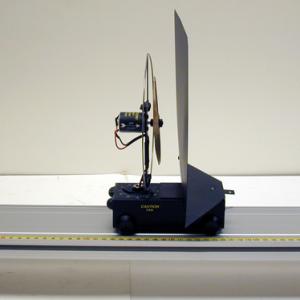College of Liberal Arts & Sciences
1H10.20 - Fan Cart & Sails
NOTE: The fan is also used for the 1C20.75 demo. See the 1C10.10 and 1J30.60 entries also.
Place the fan cart on a leveled aluminum track and turn on. When released the cart should experience constant acceleration.
When doing action/reaction turn the fan on and show that the cart will move. Place the sail on the cart and now the apparatus should stay in one place.
NOTE: On a completely frictionless surface the cart should move in the direction that the fan is blowing against the sail.
- Robert A. Morse, "Fan Unit Physics", TPT, Vol. 43, # 3, Mar. 2005, p. 162 - 165.
- Robert A. Morse, "Constant Acceleration: Experiments with a Fan-Driven Dynamics Cart", TPT, Vol. 31, # 7, Oct. 1993, p. 436.
- John W. Jewett, Jr., "DMU Physics - The Case of the Disappearing Time Intervals", TPT, Vol. 29, # 8, Nov. 1991, p. 563.
- Paul Hewitt, "Figuring Physics", TPT, Vol. 26, # 1, p. 57, January 1988.
- Pamela Lambert, "Newton's Third Survives", TPT, Vol. 24, # 7, Oct. 1986, p. 392.
- Stuart L. Mills, "Fan Blades, Roadrunners, and Coyotes?", TPT, Vol. 24, # 7, Oct. 1986, p. 392.
- C. J. Millar, "Tonque in Cheek?", TPT, Vol. 24, # 7, Oct. 1986, p. 392.
- J. Wallingford, "Obvious??", TPT, Vol. 24, # 7, Oct. 1986, p. 392.
- Carl. T. Rutledge, "The Obvious Answer Is Correct!", TPT, Vol. 24, # 7, Oct. 1986, p. 392.
- James Guillory, "Old Solution Still Correct", TPT, Vol. 24, # 7, Oct. 1986, p. 393.
- Keith Martinez and Michael Schulkins, "The H.M.S. Newton III", TPT, Vol. 24, # 7, Oct. 1986, p. 393.
- Robert Beck Clark, "Response", TPT, Vol. 24, # 7, Oct. 1986, p. 393.
- Robert Beck Clark. "The Answer is Obvious. Isn't It?", TPT, Vol. 24, # 1, p. 38, Jan. 1986.
- Earl Zwicker, Gerard Lietz, "The Sail-cart: A Free Giveaway", TPT, Vol. 20, # 9, Dec. 1982, p. 622 - 623.
- Paul Robinson, Tom Carlson, Paul Jackson, "What Limits the Speed of a Sailboat?", TPT, Vol. 18, # 3, Mar. 1980, p. 224.
- Richard S. Murphy, Jack Van Geldren, "A Note From the Real World", TPT, Vol. 16, # 5, May 1978, p. 260.
- Robert J. Brown, Jr., "Another Newton's Sail-Boat", TPT, Vol. 10, # 9, Dec. 1972, p. 488.
- J. Harris and A. Ahlgren, "Some Simple Experiments and Demonstrations", TPT, Vol. 4, # 7, Oct. 1966, p. 314.
- Brian Lamore, "Fan Cart: The Next Generation", TPT, Vol. 54, #7, Oct. 2016, p. 408-409.
- "Problem: Tacking in Still Air", AJP, Vol. 55, # 9, Sept. 1987, p. 829.
- M- 324, "Action and Reaction - Air Fan", DICK and RAE Physics Demo Notebook.
- M- 312, "Two Carts and Medicine Ball", DICK and RAE Physics Demo Notebook.
- Stanley J. Micklavzina, "Impulses with Pasco Fan Carts", PIRA News, Vol. 10, # 4, April 1996, p. 33.
- Bill Franklin, "Figuring Physics", Teaching About Impulse and Momentum, p. 2.21.
- "79, The Impossible Dream", Christopher P. Jargodzki and Franklin Potter," Mad About Physics, p. 28, 175.
- Julius Sumner Miller, Q171 & A171, Millergrams II – Some More Enchanting Questions for Enquiring Minds, p. 42 & 97.
Disclaimer: These demonstrations are provided only for illustrative use by persons affiliated with The University of Iowa and only under the direction of a trained instructor or physicist. The University of Iowa is not responsible for demonstrations performed by those using their own equipment or who choose to use this reference material for their own purpose. The demonstrations included here are within the public domain and can be found in materials contained in libraries, bookstores, and through electronic sources. Performing all or any portion of any of these demonstrations, with or without revisions not depicted here entails inherent risks. These risks include, without limitation, bodily injury (and possibly death), including risks to health that may be temporary or permanent and that may exacerbate a pre-existing medical condition; and property loss or damage. Anyone performing any part of these demonstrations, even with revisions, knowingly and voluntarily assumes all risks associated with them.

